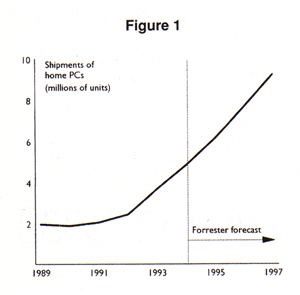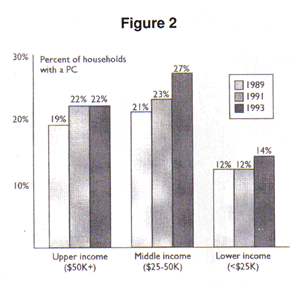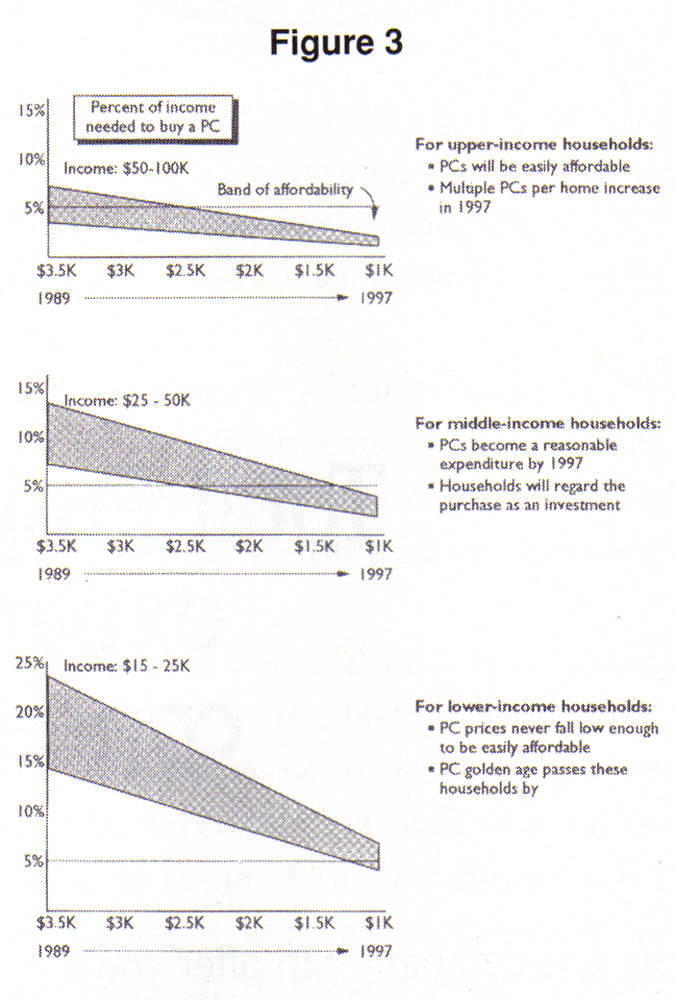Home PCs: the Golden Age is yet to come
Don't believe the hype that more than 30 percent of U.S. households own personal computers. A recent People & Technology Strategies report from Forrester Research contends that only 20 percent of U.S. families now use home PCs. By explicitly accounting for retirements of obsolete machines and households that own more than one computer, Forrester's estimate differs from those that paint a more extensive pattern of consumer PC adoption.
 "The number of consumers who have opted for PCs has been overstated," says William Bluestein, People & Technology Strategies senior analyst and author of the report. "However, this is not bad news for the industry. We believe that it means that growth in this important market has only begun to take off (see Figure 1). We estimate that both middle- and far from saturated (see Figure 2). By 1997, 42 million PCs will be humming away in American homes, up from 23 million today. This upsurge in home computing will provide a powerful magnet for content and service providers that sell to consumers."
"The number of consumers who have opted for PCs has been overstated," says William Bluestein, People & Technology Strategies senior analyst and author of the report. "However, this is not bad news for the industry. We believe that it means that growth in this important market has only begun to take off (see Figure 1). We estimate that both middle- and far from saturated (see Figure 2). By 1997, 42 million PCs will be humming away in American homes, up from 23 million today. This upsurge in home computing will provide a powerful magnet for content and service providers that sell to consumers."

Home PCs are entering their golden age. Lower prices, easier-to-use software, and the onset of new interactive services will fuel growth of this market. However, after 1997 the home PC market will become a more difficult environment for both technical and economic reasons. "By 1997, Intel's migration to RISC will set off a chain reaction throughout the industry," adds Bluestein. "This move will require Microsoft and application vendors to completely rewrite their software. Delays, incompatibilities, and uncertainties will cast a pall over the market."
 The report also predicts that in 1997 PC makers will encounter problems with extending the market to low-income households. Even though PC prices will be brought down to $1,000, this will not establish a band of affordability for this consumer segment (see Figure 3). "To reach the acceptance levels of VCRs, telephones, and television, major changes in the PC world will be needed," concludes Bluestein. "A universal computer must emerge that is intuitive, simple, low-cost (less than $500), and powerful."
The report also predicts that in 1997 PC makers will encounter problems with extending the market to low-income households. Even though PC prices will be brought down to $1,000, this will not establish a band of affordability for this consumer segment (see Figure 3). "To reach the acceptance levels of VCRs, telephones, and television, major changes in the PC world will be needed," concludes Bluestein. "A universal computer must emerge that is intuitive, simple, low-cost (less than $500), and powerful."
The report, "Home PCs: The Golden Age," is part of People & Technology Strategies, a Forrester research service that analyzes technology's impact on consumers.
Gender equity in on-court action
If you have cable TV, you know that you could watch basketball 24 hours a day if you were so inclinedthere is always at least one game on. What you may not know is that TV coverage does not accurately reflect the level of participation in the sport by women. The North Palm Beach, Fla.-based American Basketball Council, through American Sports Data, does an annual survey of the sports' health and popularity. And the most recent poll discovered that 41 percent of players 12 to 17 are female. (The ABC also reports that National Basketball Association games were televised in 141 countries in 1992-93, so the broadcast phenomenon is not isolated to the U.S.) In 1993, 42.1 million Americans played basketball at least once, making it the most popular participation sport in the country, and some 13 million of those players are women.
People are playing more than ever, too. In 1987, participants hit the court 36 times a year; the number rose to 46 in the most recent survey. In the latest survey, measuring round-ball activity in 1993, women played an average of 36 days a year; men played almost once a week on average. While women's professional basketball enjoys much more success in Europe than it has in the U.S., activity at the collegiate level is impressive: 1,573 colleges and junior colleges have women's ball programs, 57 percent of which are head-coached by a women.
The downside of downsizing
As usual, bigwigs' decisions have proven to most affect the worker bees. Penton Research Services, a division of Penton Publishing, Cleveland, reports that the flurry of staff cuts that took place in business and government during the late '80s has resulted in increases in remaining employees' workloads. American industry, Penton speculates, has gone beyond a helpful trimming of dead wood and has possibly cut back (perhaps because of fears generated by the potential for changes in employers' obligations with regard to workers' health care) to a point that will eventually result in a kind of mass burnout among the country's workforce.
Almost 87 percent of the purchase-decision makers surveyed said their workload has grown in the last five years. Government workers (95 percent) reported longer dockets most frequently, though some would argue that they most needed more things to do. Some 91 percent of workers in wholesale and retail trade noted increases. The number was 90 percent among those in processing industries. The lowest level of increase was found in agriculture, mining and construction all of which have strongly unionized workforces; still, 76 percent of workers there said their job descriptions now included more tasks that ever.
Kids with money
Teenage Research Unlimited says that teenagers spent $99 billion in 1994, and believe it or not, all of that money did not go toward basketball shoes and game cartridges. They reportedly earned about $96 billion last year - they must all be heading into careers in government. Kids' earnings were up a whopping 12 percent over '93 numbers.
The Northbrook, Ill., firm queried 2,081 kids 12 to 18 and found that boys spend about $68 each week and girls spend $65. Of the $99 billion, $63 billion was their own money; the remainder came out of the family stash. Daughters spend more family money than sons. Boys, on average, earn $18 more per week than girls. Kids' money sources include parental handouts (47 percent), occasional jobs (45 percent), allowances (32 percent), part-time jobs (28 percent) and full-time jobs (11 percent).
Right now, there are 28.5 million people between 12 to 19 in the U.S., and the growth in the number of teens in America that started in 1992 is expected to continue for another 15 years.
Too much work, too little love
Remember that woman? You know, that one who was wearing the white dress on the day you were sporting a tuxedo. Here's a hint: wife. You may recall this person as someone you'd like to spend a great deal of time with, but if you're like the readers of Exec magazine, published by Rodale Press, Emmaus, Penn., you may not be very familiar with her anymore. In a recent survey of 3,000 Exec readers, more than half of aU respondents said they work a minimum of 60 hours a week: 29 percent say they work 70 or more hours per week. There's no telling how much of that is "woe-is-me" whining, but it is clear that the heavy workload is taking its toll on American marriages. Some 58 percent of survey respondents said their work habits cause monthly arguments at home.
Since 54 percent said they're usually too tired for a little off-the-cuff romance, it's no wonder there's trouble on the home front. More than a quarter of the men (28 percent) said their long hours at the shop had prompted their wives to accuse them of smooching somebody at work. (Twenty-seven percent of respondents admit that they feel they have more in common with female colleagues than they do with their wives.) When they do get together with their spouses, most men say they talk (35 percent). Other popular activities include watching television (30 percent) and sleeping (27 percent). Sex is less popular- 10 percent cited it.
Even though they say they're working like dogs, more than half of survey respondents (57 percent) said they spend more time with their families than their fathers' did - a finding that may indicate guys are painting a somewhat idealized picture of their lives.
Taking 'em to school
After polling, by phone, 15,000 school districts. Market Data Retrieval, Shelton, Conn., has determined that for the 1994-95 school year, there are 43.7 million kids enrolled in public schools. The firm says this is the largest number of kids the public schools have been charged with since the mid-'70s. There are 470,000 more kids in public schools this year than there were in '93-94. MDR estimates that enrollments will continue to increase through 1996 in response to the growth in the number of kids born in the late '80s. Middle schools gained the most students, 183,000, while senior highs added 174,000 and grade schools made room for 113,000 more kids.
Twelve states- California, Texas, New York, Florida, Illinois, Ohio, Pennsylvania, Michigan, Georgia, New Jersey, North Carolina and Virginia - account for 58 percent of total public school enrollment; each of those serves more than 1 million students. California tops the list with 5.3 million kids in public schools. The fastest growing rolls, by county, were found in the five boroughs of New York City, followed by Clark, Nevada; Harris, Texas; Maricopa, Arizona; and Dallas.
Violence among teens in towns both big and small- is widespread
Violence among teens in towns of all sizes is prevalent, and many teens feel their schools have become more dangerous, according to a survey recently conducted by Roper Starch Worldwide, New York City, for the nationally syndicated television talk show "Rolonda," with the consultation of the Harvard School of Public Health. The survey indicates that 31 percent of high school and junior high or middle school students think teen violence is a serious problem in their own school, and 45 percent think violence in their school has become "more dangerous over the past five years." On a more positive note, the study found nearly three in four students whose schools have made efforts to reduce violence believe they have been "'very" or "somewhat effective."
A major report by Roper Starch presents findings from a national projectable telephone survey of children, primarily between the ages of 12 and 17, on the subject of teenage violence and crime. An equal number of boys and girls were randomly interviewed for a total sample of 502 high school and junior high or middle school students. The survey was conducted between October 20 and October 26, 1994. The margin of error is plus or minus 4.4 percentage points on the total, and much larger for subsamples.
The study found several differences- both expected and unexpected in levels of violence. While violence is typically more common among boys than girls and among high school versus junior high and middle schools as expected, the survey yielded the surprising findings that violence often varies more by geographical region than by size of city. (Roper Starch suggests that regional differences may in part be explained by the greater presence of gangs in areas such as the West. And the fact that violence is in many ways no more prevalent in large cities than small cities and suburbs/rural areas may be due to greater security measures in many inner-city schools.)
Examples of expected differences:
Thirty-four percent of boys versus 11 percent of girls "have been in a fight in the past year." More than twice as many high school students as junior high/middle school students currently usually carry a weapon (16 percent versus 7 percent).
Examples of unexpected differences:
Violence is typically most prevalent in the West and least prevalent in the Northeast: 30 percent of students in the West have been in a fight in the past year, compared to 23 percent in the South, 18 percent in the Northeast, and 17 percent in the Midwest.
Violence is often most problematic in small cities: 17 percent of students in small cities currently carry a weapon, compared to 12 percent in suburbs and rural areas and just nine percent in large cities.
Other major findings in the survey included the following. Violence among teenage students today is widespread: 22 percent have been in a fight in the past year; 17 percent claim to have "ever been robbed at gun and/or knife point;" 13 percent currently carry a weapon (a gun, knife, razor, or some other type of weapon).
Violence and the threat of violence affects students in a variety of ways. Fifty-four percent "feel angry." Twenty-five percent "have more difficulty concentrating in class." Twenty-one percent are "less eager to speak up in class." Seventeen percent "want to change schools or consider changing schools." Seven percent "stay home from school or skip classes."
Students commonly know people who are involved in violence. Fifty-one percent know someone (whether it be a teenager or an adult) who carries a weapon to school or in their neighborhood. Forty-two percent know someone "who is involved in a gang." Forty-one percent know someone in their own home who owns a gun. Thirty-four percent know someone "who has been shot." Seventeen percent know someone who "has been killed as result of violence."
Most schools are taking actions to prevent violence. and students think they have been effective. Twenty-six percent of students say their schools have "had a program or class to prevent violence." Twenty percent "have peer mediators." Twelve percent take both approaches.
Students in large cities are most apt to say their school has had a special class or peer mediators. Overall, while 35 percent of all students say their school has taken neither of these steps, only 24 percent of students in large cities say this, compared to 37 percent of students in small cities, and 43 percent of students in suburban and rural areas.
Students believe in the efficacy of these efforts. Nearly three in four students whose schools have had antiviolence classes and/or peer mediators (73 percent) say they have been effective, with 22 percent saying they have been "very effective."
